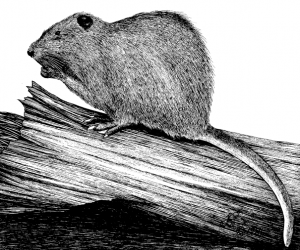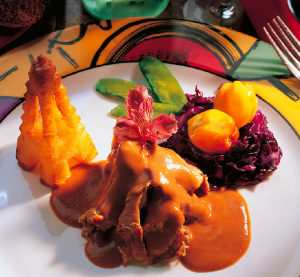 Myocastor coypus
Myocastor coypusNative range: Temperate and subtropical South America
Invasive range: Established in 16 states; abundant in the Gulf Coast but found as far west as Oregon and Washington
Nutria, also known as coypu and river rat, is native to temperate and subtropical South America. It has been introduced to Europe, Asia, and Africa, mainly for fur farming. These voracious, herbivorous, semiaquatic rodents were brought to the US in 1889 for their fur; smaller than a beaver, larger than a muskrat—as everywhere else, they escaped into wetlands, chewing through whatever needed to be chewed through (rubber tires, wood siding) along the way.
In the 1940s, feral nutria were promoted as a means of controlling water hyacinth (another invasive species) and as a recreational source of wild pelts and meat. By the 1950’s there were 20 million nutria in Louisiana alone.
Crops and levees were being damaged by their munching and digging. Should the state promote their fur—and protect their numbers—as a natural resource, or declare them a pest and get rid of them? The state got all that worked out, siding with the furiers, when, in the 1980s, the bottom fell out of the international fur market.We’ll probably be seeing more of the nutria. Climate change, accompanied by heavier rains in some areas, may extend their range north, since they would rather swim than walk.
For more recipes and information on nutria biology see www.nutria.com
Slow Cooked Nutria
From the Louisiana Department of Wildlife and Fisheries
Serves four
2 hind saddle portions of nutria meat
1 small onion, sliced thinly
1 tomato, cut into big wedges
2 potatoes, sliced thinly
2 carrots, sliced thinly
8 Brussels sprouts
1/4 glass white wine
1 cup water
2 teaspoons chopped garlic
1. Layer onion, tomato, potatoes, carrots and Brussels sprouts in a slow cooker.
2. Season nutria with salt, pepper and garlic, and place it over vegetables.
3. Add wine and water, cook on a low heat until meat is tender (approximately 1 1/2 hours).
4. Garnish with vegetables.
Nutria, Wild boar, and crawfish egg roll towers
From Prejeans Restaurant in Lafayette, Louisiana
What’s not to love about this recipe, which calls for not one but three invaders?
Makes 20 egg rolls
2 1/2 pounds ground nutria
1/2 pound ground wild boar
1/2 pound crawfish tails, chopped fine
1/2 cup water chestnuts, chopped
1/2 pound shiitake mushrooms, chopped
1/4 cup sliced green onions
11/2 tablespoons Thai-style seasoning
20 egg roll wrappers
1 egg, beaten
Peanut oil for deep-frying
1. In a large bowl, mix the nutria, wild boar, crawfish, water chestnuts, mushrooms, onions, and Thai seasoning. Brown the mixture in a heavy skillet over medium-high heat.
2. Remove from the heat, drain, and cool.
3. Place 2 ounces of the mixture in each egg roll wrapper. Follow directions on the wrapper package for rolling and sealing the egg rolls.
4. Pour 3 inches of oil into a heavy, deep saucepan. Heat the oil to 350 degrees. Fry the egg rolls until golden brown.
5. Place three egg rolls in another wrapper and brush the edges of the wrapper with the beaten egg. Fold the edges over to create a bundle. Repeat until you have used up all the egg rolls. Fry the bundles until golden brown.
6. Slice open each bundle across the top on the bias. Place the egg rolls upright on a plate and serve with a sweet and spicy sauce.



























